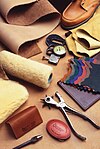Suede

Suede (pronounced /sweɪd/ (SWAYD)) is a type of leather with a fuzzy, napped finish, commonly used for jackets, shoes, fabrics, purses, furniture, and other items. The term comes from the French gants de Suède, which literally means "gloves from Sweden".[1]
Suede is made from the underside of the animal skin, which is softer and more pliable than the outer skin layer, though not as durable.[2]
Production[]
This section does not cite any sources. (August 2021) |

Suede leather is made from the underside of the skin,[3] primarily from lamb, although goat, calf, and deer are commonly used. Splits from thick hides of cow and deer are also sueded, but, due to the fiber content, have a shaggy nap.
Characteristics[]
This section does not cite any sources. (August 2021) |
Because suede does not include the tough exterior skin layer, it is less durable, but softer, than the standard "full-grain" leather. Its softness, thinness, and pliability make it suitable for clothing and delicate uses; suede was originally used for women's gloves, hence its etymology (see above). Suede leather is also popular in upholstery, shoes, bags, and other accessories, and as a lining for other leather products. Due to its textured nature and open pores, suede may become dirty and quickly absorb liquids.
Sueded fabrics[]
Fabric sueding is carried out on a sueding machine with abrasive covered rollers; the machines can suede both sides of fabric, whether woven or knitted.[4] Creasing and variations in the center selvedge are two major concerns with sueded fabrics.[5] Fabrics that have been sueded or emerized are known as 'sueded fabrics' or 'emerized fabrics.' [6][7][8]
Sueding[]
Sueding is a mechanical finishing process that exposes the material to an abrasive surface, creating a small, soft pile. The abrasion mechanism may be equipped with sandpaper, emery paper or carbon brushes.[6][7]
Sueding action[]
The abrasive material on the machine's rollers cuts and shreds surface fibres, resulting in a soft texture with a short pile.[9]
Trademarked sueded fabrics[]
Alcantara and Ultrasuede are trademarked names for a plush microfiber with a feel resembling soft suede; this type of material is more durable and resistant to liquids and stains, and can be used in upholstery, accessories, clothing or shoes.[10][11]
In popular culture[]
- Suede's absorbent nature was highlighted in the Seinfeld episode "The Jacket", in which Jerry ventures outside into the snow and ruins his exorbitantly priced suede jacket.
- "Blue Suede Shoes" is a well-known early rock-n-roll song written by Carl Perkins and also covered by Elvis Presley.
- "Weird Al" Yankovic wrote and performed the song "King of Suede".
See also[]
References[]
- ^ Suede, Dictionary.com
- ^ "Difference Between Leather and Suede - Explainry". Explainry. Retrieved 2017-02-11.
- ^ Scrivano, Sandy (2001). Sewing with Leather and Suede: Tips, Techniques and Inspiration. Lark Books. p. 120. ISBN 978-1-57990-273-5.
- ^ Textile Manufacturer & Knitting World 1977: Iss 1. Internet Archive. Textile Manufacturer. 1977. p. 19.
{{cite book}}: CS1 maint: others (link) - ^ Textile Technology Digest 1996-06: Vol 53. Internet Archive. Textile Information Center. 1996. p. 62.
{{cite book}}: CS1 maint: others (link) - ^ a b Elsasser, Virginia Hencken (2005). Textiles : concepts and principles. Internet Archive. New York, NY : Fairchild Publications. p. 231. ISBN 978-1-56367-300-9.
- ^ a b A.T.A. Journal. Adsale Publishing Company. 2006. p. 24.
- ^ "Definition of SUEDE". www.merriam-webster.com. Retrieved 2021-08-03.
- ^ Joseph, Marjory L. (1992). Joseph's introductory textile science. Internet Archive. Fort Worth : Harcourt Brace Jovanovich College Publishers. p. 339. ISBN 978-0-03-050723-6.
- ^ "Alcantara: sustainability and versatility". Alcantara. Retrieved 2021-08-03.
- ^ "The Indian Head Connection - Skinner & Sons | Fabrics.net Fabrics.net". Retrieved 2021-08-03.
Further reading[]
- American Leather Chemists Association ALC (1906). The Journal of the American Leather Chemists Association. American Leather.
- Bredenberg, Jeff (1999). Clean It Fast, Clean It Right: The Ultimate Guide to Making Absolutely Everything You Own Sparkle & Shine (New ed.). Rodale Books. p. 544. ISBN 1-57954-019-8.
- Burch, Monte (2002). The Ultimate Guide to Skinning and Tanning: A Complete Guide to Working with Pelts, Fur, and Leather (First ed.). The Lyons Press. p. 240. ISBN 1-58574-670-3.
- Churchill, James E. (1983). The Complete Book of Tanning Skins and Furs. Stackpole Books. p. 197. ISBN 0-8117-1719-4.
- Goldstein-Lynch, Ellen; Sarah Mullins; Nicole Malone (2004). Making Leather Handbags and Other Stylish Accessories. Quarry Books. p. 128. ISBN 1-59253-076-1.
- Kite, Marion; Roy Thomson (2005). Conservation of Leather and Related Materials. Butterworth-Heinemann. p. 240. ISBN 0-7506-4881-3.
- Michigan Historical Reprint Series (2005). The Art of Tanning Leather. Scholarly Publishing Office, University of Michigan Library. p. 266. ISBN 1-4255-2365-X.
- O'Flaherty, Fred; Roddy Lollar (1956). The Chemistry and Technology of Leather. ACS Monograph 134 (1978 ed.). American Chemical Society, Krieger Publishing Co. ASIN B007EUI5M4.
- Parker, Sybil P (1992). McGraw-Hill Encyclopedia of Science & Technology: An International Reference Work. New York: McGraw-Hill. p. 508. ISBN 0-07-909206-3.
External links[]
 Media related to Suede at Wikimedia Commons
Media related to Suede at Wikimedia Commons
- Leather
- Textile techniques
